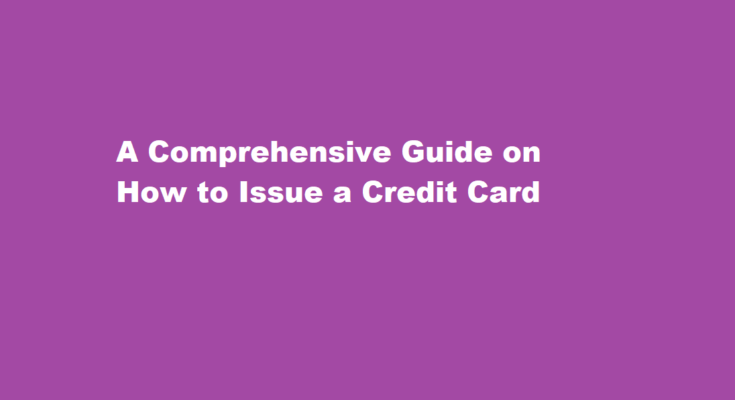Introduction
Credit cards have become an integral part of modern financial transactions. They offer convenience, flexibility, and a host of benefits to both consumers and businesses. If you are a financial institution or a business looking to issue credit cards, it’s essential to understand the process thoroughly. In this comprehensive guide, we will walk you through the steps to issue credit cards, ensuring that you do so responsibly and efficiently.
Legal Compliance
Before diving into the process of issuing credit cards, you must ensure that you comply with all relevant laws and regulations. Credit card issuance is tightly regulated to protect consumers and maintain the stability of the financial system. Consult with legal experts to navigate the complex web of rules and regulations governing credit card issuance in your jurisdiction.
Establish Your Credit Card Program
To issue credit cards, you need to have a well-defined credit card program in place. This program should outline the terms and conditions of the credit cards you will offer, including interest rates, fees, credit limits, and rewards programs. Decide whether you want to issue traditional credit cards, secured credit cards, or co-branded cards in partnership with other businesses.
Partner with a Payment Network
To issue credit cards, you need to partner with a payment network, such as Visa, Mastercard, American Express, or Discover. Payment networks provide the infrastructure and technology necessary to process credit card transactions. Choose a payment network that aligns with your business goals and customer base.
Credit Underwriting
One of the most critical steps in issuing credit cards is assessing the creditworthiness of applicants. Implement a robust credit underwriting process to evaluate applicants’ financial history, income, and ability to repay. This step is crucial in mitigating the risk of defaults and fraud. You may also want to offer different card options with varying credit requirements to cater to a broader customer base.
Application and Approval
Design a user-friendly credit card application process that collects all necessary information from applicants. Utilize secure technology for data encryption and storage to protect applicants’ personal and financial data. Streamline the approval process to ensure quick responses to applicants, and provide clear communication regarding approval or rejection.
Card Production
Once an application is approved, it’s time to produce the physical credit card. Work with card manufacturers to design and produce cards that reflect your brand and meet the security standards set by payment networks. Ensure that cards are delivered securely to cardholders’ addresses.
Account Management
Implement a robust account management system to monitor cardholders’ activity, send monthly statements, and handle customer inquiries and disputes. Provide online account access and mobile apps for cardholders to manage their accounts conveniently.
Risk Management
Credit card issuance involves inherent risks, such as fraud and defaults. Implement comprehensive risk management strategies, including fraud detection systems and credit monitoring, to mitigate these risks. Regularly review and update risk management protocols to stay ahead of evolving threats.
Marketing and Promotion
To attract cardholders, you need effective marketing and promotion strategies. Highlight the benefits of your credit cards, such as cashback rewards, travel perks, or low-interest rates. Leverage digital marketing channels and partner with other businesses for co-branded marketing efforts.
Ongoing Support
Provide exceptional customer support to cardholders. Offer 24/7 customer service, easily accessible through various communication channels, such as phone, email, and chat. Address cardholders’ concerns promptly and professionally to build trust and loyalty.
Frequently Asked Questions
What is the credit card limit?
In very simple terms, the Credit Limit or the Credit Card Limit is the maximum amount that a person can spend on his or her Credit Card. This limit is something that the issuing company fixes.
How do banks approve credit cards?
Your credit score is the biggest single factor in whether you’ll be approved. If your credit score is high, you should qualify for a relatively low-interest rate and better perks. If your credit score is low, you’ll qualify only for a higher-interest card.
Conclusion
Issuing credit cards is a complex process that requires careful planning, legal compliance, and risk management. By following the steps outlined in this guide, you can establish a successful credit card program that benefits both your organization and cardholders. Remember that responsible credit card issuance involves prioritizing the financial well-being of your customers while maintaining the integrity and security of the credit card system.
Read Also : Crafting Delicious and Nutrient-Packed Smoothies at Home



